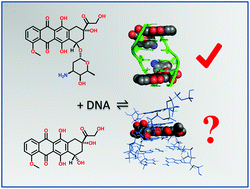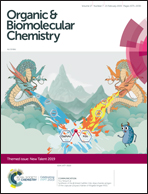Investigations into the DNA-binding mode of doxorubicinone†
Abstract
Cancer treatment is one of the major challenges facing the modern biomedical profession. Development of new small-molecule chemotherapeutics requires an understanding of the mechanism of action for these treatments, as well as the structure–activity relationship. Study of the well-known DNA-intercalating agent, doxorubicin, and its aglycone, doxorubicinone, was undertaken using a variety of spectroscopic and calorimetric techniques. It was found that, despite conservation of the planar, aromatic portion of doxorubicin, the agylcone does not intercalate; it instead likely binds to the DNA minor-groove.

- This article is part of the themed collections: Mechanistic, computational & physical organic chemistry in OBC and New Talent


 Please wait while we load your content...
Please wait while we load your content...